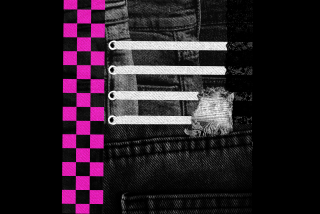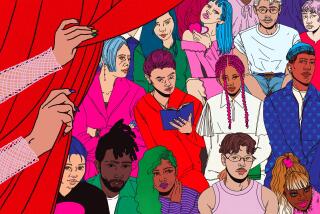Why Do I Look Like Me? : As early as 2, children notice how they differ from others. Next, they want to know why, what it means.
Bill Sparks sat in front of his third-grade class at the 36th Street School in Los Angeles, reading aloud from âThe Gingerbread Man,â when, suddenly, he was asked a question that stumped him.
âWhat color am I?â asked a 9-year-old student. âWhat color is my skin?â
The boy, who was Latino, said he already knew his skin was brown, but he wanted to know exactly what shade.
Sparks, who is Anglo, sat there staring at the youngster.
âI just didnât know,â says the longtime teacher, who is co-chairman of the L.A. Unified School Districtâs Multicultural Education Committee and has written extensively about children and racial awareness. âWe donât have names for 20 shades of brown, not that I know of.â
Sparks told the boy he would attempt somehow to find a name, and if he couldnât, they would huddle together and make one up.
That having been said, seven more children raised their hands and wanted to know their exact colors.
âNot every kid is so observant,â Sparks says. âBut some children pick up on everything. They try to understand the world and their place in it. They are trying to make sense of their own individuality and the physical differences they observe between people.â
It may surprise some adults, but children do observe racial and ethnic differences at an extremely early age.
Research done as early as the 1940s by noted psychologists Kenneth and Mamie Clark--and substantiated by more recent studies by Louise Derman-Sparks (Billâs wife) and other educators at Pacific Oaks College in Pasadena--indicate that between ages 2 and 3 children begin recognizing differences in characteristics such as skin color, facial features and hair texture.
By the time they enter kindergarten or elementary school, children are headed full throttle toward some level of racial or ethnic awareness. And often, experts say, their observations can be accompanied by attitudes--toward themselves and others.
Some are positive, some negative, depending in large part on who and what influences them.
âYoung children ask a lot of questions about (racial) differences,â says Sparks, who believes such questions should be answered by parents and teachers clearly, honestly, with sensitivity and without bias. âThey pick up on the responses of adults and they pick up the values of those adults, including biases. They also are influenced by other kids and what they see on TV and in movies.â
In some cases, children begin placing values on physical differences almost as soon as they notice them, according to former teacher Jackie Carter, editorial director of early childhood publications at Scholastic Inc., in New York. âBecause of day care, children in our society are being exposed to these differences at an earlier age,â she says. âHopefully, parents and teachers will celebrate the differences. Hopefully, theyâll say, âYes, we are all different, isnât that wonderful.â â
For many white children, the stumbling block is overcoming lingering prejudice--some overt, some subtle--handed down from previous generations and passed along from other sources.
For numbers of minority children, the obstacle is negative experiences that occur because they are âdifferent.â
For both groups, the paths leading to a celebration of differences are intertwined.
The cold reality is that a minority childâs racial awareness often is turbocharged by a negative incident, says Gail Elizabeth Wyatt, a professor of medical psychology at UCLA.
âSuch an incident can be devastating,â she says. âI know of one nursery school boy who was called a chocolate bar by one of his peers. He broke into tears.
âChildren become teasers when they are quite young. Unfortunately, if a child is somehow different, thereâs usually a connotation that he is deficient. Itâs a sad way to start your self-concept, feeling there is something wrong with you.â
By age 6, Wyatt says, many minority children are acutely aware of âpower terms,â words with bad intentions--used by others to hurt, anger, provoke and insult by making fun of oneâs race or ethnic background.
For their part, white youngsters hear the words, learn them and repeat them, Wyatt says. âIf parents donât intervene, they go on using them. Between the ages of 9 to 11, we have budding racists.â
In truth, when young children use racial slurs, often the very source is their parents.
âChildren are a product of their world,â Wyatt says. âRacism begins at home.â
None of this is breaking news to Maurice Wire, 27, of Palmdale. A few years ago, before Wire graduated from Azusa Pacific University, he delivered pizzas for a restaurant chain.
One night, he took in a large dose of hand-me-down, juvenile racism.
âWhen I walked up to deliver a pizza,â says Wire, who is black, âthis 7-year-old white kid opened the door. I was standing there, waiting for his father to come over to pay, when the boy referred to me with a racial slur.
âI just stood there.
âThe kid tugged on his fatherâs pants, and repeated the slur two more times. The father looked nervous while I took my time counting out his change. Finally, the guy says, âKeep the change,â and shut his door.
âThe change was over $5.
âI just thought, âMan, you got caught.â The boy was just repeating what heâd heard in the past from his father.â
Wire says he can deal with racism, and he is working to ensure that his own children receive the emotional support they need to do likewise.
A year ago, Wire married Cathy, a Filipino-Mexican-American who has four children by a previous marriage. Two months ago, the couple had a daughter, Catherine.
Once, Wire had to explain to his three stepsons--David, Lance and Daniel--why his hair is âfuzzyâ and theirs isnât.
âLance, who is 7, wanted me to cut his hair short so it would look like mine,â Wire says. âI cut it short, but it didnât come close to looking like mine. He was confused and kind of mad.
âI told him, âMy hair is curly because my parentsâ hair is curly,â that my parents are black. âYours is straight because your parentsâ hair is straight,â that they are Mexican and Filipino.â
That direct kind of answer is necessary to help young children understand who they are and whence they came, experts say.
âChildren need to understand why they are different, what makes them distinct, what group they emanate from,â Wyatt says.
Although children of different ethnic backgrounds sometimes face different obstacles, she says, the overriding issues for children of color is the same: white culture has been established as the norm in this country.
âChildren must realize, however, that there is no racial norm for whatâs acceptable or appropriate,â she says. â(The norm) should be flexible to include all people.â
To make sure their two sons understood this, Chris and James Cook of Pasadena began explaining their heritage to each child before his second birthday.
âWe told them who we are--Iâm Mexican-American and my husband is Creole: French, native American and African-American,â Chris Cook says. âWe began teaching them to be proud of their ethnicity. I wanted them to be prepared if anyone said anything racist to them.â
They didnât have to wait long. When the Cooksâ oldest son, Christian, was 4, a boy at his day-care center said he wouldnât play with him because he is black. Christian, outwardly, at least, came away from the incident in better shape than his parents.
âWhen we heard about it, my husband and I both sat down and cried,â Cook says. âNow, I tell Christian all the time that I love his pretty brown skin. I want him to feel good about himself. And, now, he really has a great sense of pride in his skin color.â
Conversations between parents and children are essential, Wyatt says, for minority toddlers to make sense out of sometimes puzzling confrontations.
âMost of these children donât know how to deal with it when they are mistreated because of the color of their skin,â she explains. âThey need to have ongoing talks with their parents--things go on everyday at school. The more a parent addresses it, the better.â
Adds Luz Myles, a probation officer assigned to assist troubled children in the Duarte School District: âIf (parents) donât talk to them, the kids feel as though they have to just take it. And that hurts. It can affect their whole life.
âSometimes, they turn to gangs--at 8, 9, 10 years old--because the gangs will accept them when they feel no one else will.â
Overt racism isnât always to blame for low self-esteem, says Sparks, the co-author with his wife of the book, âAnti-Bias Curriculum: Tools for Empowering Young Children.â
âThere are more subtle messages picked up by kids telling them they are unimportant, or reinforcing a stereotype,â he says. âFor example, PA announcements at school may be all in English, even though only 50% of the students understand the English.
âSome people may say everyone was treated equally in that case, but the information didnât go into every ear because certain children couldnât process that.â
The effects of such messages are illustrated, in part, by the numbers of minority children in preschool who prefer to play with white dolls rather than brown or black dolls.
âWe have white, Hispanic, black, and Chinese kids in my classes,â says Marjorie Rose, who has worked in the Monrovia School Districtâs Child Development Center for 11 years. âThey all want to play with white dolls. Even the 2- and 3-year-olds choose the white dolls.
âSomehow thatâs their idea of whatâs good, whatâs beautiful.â
Wyatt says studies have been conducted by the Clarks and other psychologists among young children who have been shown a light-skinned doll and a dark-skinned doll, and were then asked: Who do you want to be like?
âMost of the children picked the fairer-skinned doll,â she says. âIn some recent studies, the results have varied, depending on the children involved.â
White youngsters can be befuddled by uneven treatment toward children of color; Sparks says they begin perceiving such inequities between ages 5 and 7. Their challenge, he continues, is to break free of racism in all of its forms.
âFrom an early age, white children are often invited to join in prejudice and discrimination,â Sparks says, whether it is based on ethnicity, cliques or name-calling.
If a parent allows a child to participate in name-calling or make generalizations about other people, Sparks says, the seeds of prejudice may be planted.
Given a balanced home environment, Sparks says, children can also recognize racial injustice and react in a constructive manner.
âAt 5 and 6, they can sense what is fair and what isnât fair,â he says. âThey can begin to be critical thinkers on cultural and racial issues.
Around the country, many school districts including the Los Angeles Unified have started or are considering adopting anti-bias and multicultural programs.
Last year, a kindergarten class at Cheltenham Elementary School, near Philadelphia, compiled a book for kids that lyrically lists the ways children are alike and different. The book, âWe Are All Alike . . . We Are All Different,â will be published by Scholastic this year.
âAll the ideas in the book are the kidsâ,â says teacher Rosalind Goldberg, whose class includes four blacks, three Asians, two Latinos and 16 Anglos.
Lines from the book include:
We are all alike. We are all people.
We are all different. Some of us have darker skin. Some of us have lighter skin.
We are all alike . . . We all have hearts and brains.
According to Goldberg, the childrenâs awareness is remarkably keen.
âThe kids compared themselves to snowflakes,â she says. âThey recognize that snowflakes all have six points, but none of them are exactly alike. They know they have their differences and that those differences make them unique. But they are the same, they are all people.â
More to Read
Sign up for Essential California
The most important California stories and recommendations in your inbox every morning.
You may occasionally receive promotional content from the Los Angeles Times.










